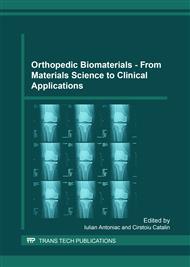[1]
H. Ma, C. Jiang, D. Zhai, Y. Luo, Y. Chen, F. Ly, Z. Yi, Y. Deng, J. Wang, J. Chang, C. Wu, A bifunctional biomaterial with photothermal effect for tumor therapy and bone regeneration. Adv. Funct. Mater, 26 (2016), 1197-1208.
DOI: 10.1002/adfm.201504142
Google Scholar
[2]
A.R. Amini, C.T. Laurencin, S.P. Nukavarapu, Bone tissue engineering: recent advances and challenges, Crit Rev Biomed Eng, 40 (2012), 363-408.
DOI: 10.1615/critrevbiomedeng.v40.i5.10
Google Scholar
[3]
N. Bock, A. Riminucci, C. Dionigi, A. Russo, A. Tampieri, E. Landi, V.A. Goranov, M. Marcacci, V. Dediu, A novel route in bone tissue engineering: Magnetic biomimetic scaffolds, Acta Biomater. 6 (2010), 786-796.
DOI: 10.1016/j.actbio.2009.09.017
Google Scholar
[4]
S. Naznin, Biodegradable polymer-based scaffolds for bone tissue engineering, SpringerBriefs in Applied Sciences and Technology, (2013).
Google Scholar
[5]
P.X. Ma, Biomimetic materials for tissue engineering, Adv. Drug Deliv. Rev. 60 (2008), 184–198.
Google Scholar
[6]
H.M. Wang, Y.T. Chou, Z.H. Wen, Z.R. Wang, C.H. Chen, M.L. Ho, Novel biodegradable porous scaffold applied to skin regeneration. PLoS ONE 8(2013), e56330.
DOI: 10.1371/journal.pone.0056330
Google Scholar
[7]
M.A. Barbosa, A.P. Pego, I.F. Amaral, Chitosan, Materials of Biological Origin, Elsevier Ltd (2011), 221-237.
Google Scholar
[8]
M. Azami, A.I. Jafar, S. Ebrahimi-Barougha, M. Farokhic, S.E. Fard, In vitro evaluation of biomimetic nanocomposite scaffold using endometrial stem cell derived osteoblast-like cells, Tissue and Cell 45 (2013), 328– 329.
DOI: 10.1016/j.tice.2013.05.002
Google Scholar
[9]
S.V. Dorozhkin, Bioceramics of calcium orthophosphates, Biomaterials 6 (2010), 2773-86.
Google Scholar
[10]
W.W. Thein-Han, R.D.K. Misra, Biomimetic chitosan-nanohydroxyapatite composite scaffolds for bone tissue engineering, Acta Biomaterials 5 (2009), 1182-1197.
DOI: 10.1016/j.actbio.2008.11.025
Google Scholar
[11]
J. Wang, C. Liu, Biomimetic collagen/hydroxyapatite composite scaffolds: fabrication and characterizations, Journal of Bionic Engineering 11(2014), 600-601.
DOI: 10.1016/s1672-6529(14)60071-8
Google Scholar
[12]
M. Kikuchi, T. Ikoma, S. Itoh, H. N. Matsumoto, Y. Koyama, K. Takakuda, K. Shinomiya, J. Tanaka, Biomimetic synthesis of bone-like nanocomposites using the self-organization mechanism of hydroxyapatite and collagen, Comp. Sci. and Tech 64 (2004).
DOI: 10.1016/j.compscitech.2003.09.002
Google Scholar
[13]
H. Fatemeh, M.E. Bahrololoom, In situ preparation of iron oxide nanoparticles in natural hydroxyapatite/chitosan matrix for bone tissue engineering application, Ceramics International 4 (2015), 3094–3100.
DOI: 10.1016/j.ceramint.2014.10.153
Google Scholar
[14]
V. Karageorgiou, D. Kaplan, Porosity of 3D biomaterial scaffolds and osteogenesis, Biomaterials, 26 (2005), 5474-5491.
DOI: 10.1016/j.biomaterials.2005.02.002
Google Scholar
[15]
N. V. Afanaseva, V. A. Petrova, E. N. Vlasova, S. V. Gladchenko, A. R. Khayrullin, B. Z. Volchek, A. M. Bochek, Molecular mobility of chitosan and its interaction with montmorillonite in composite films: dielectric spectroscopy and FTIR studies, Polym. Sci. Ser. A Chem. Phys. 55 (2013).
DOI: 10.1134/s0965545x13120018
Google Scholar
[16]
K. Jagadeeswara Reddy, K.T. Karunakaran, Purification and characterization of hyaluronic acid produced by Streptococcus zooepidemicus strain 3523-7, J. BioSci. Biotech. 2 (2013), 173-179.
Google Scholar
[17]
Y. Wu, Preparation of low-molecular-weight hyaluronic acid by ozone treatment, Carbohydr. Polym. 89 (2012), 709–712.
DOI: 10.1016/j.carbpol.2012.03.081
Google Scholar
[18]
Y. Zhai, F.Z. Cui, Recombinant human-like collagen directed growth of hydroxyapatite nanocrystals, J. Cryst. Growth, 291 (2006), 202–206.
DOI: 10.1016/j.jcrysgro.2006.03.006
Google Scholar
[19]
J. C. Stockert, A. Blázquez-Castro, M. Cañete, R. W. Horobin, Á. Villanueva, MTT assay for cell viability: Intracellular localization of the formazan product is in lipid droplets, Acta Histochemica, 114 (2012), 785–796.
DOI: 10.1016/j.acthis.2012.01.006
Google Scholar


